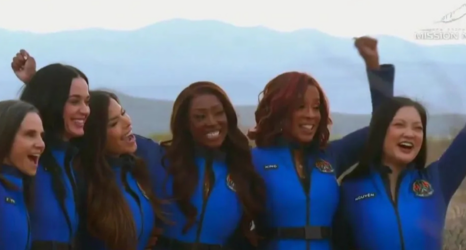It’s hard to imagine a more inspirational place than Space Camp.
Since the 1980s, generations of youth have learned what it takes to be an astronaut. Some have gone on to fly in space; many more have gone on to great careers in science and engineering. All have been inspired to follow their dreams and work toward lofty goals.
For too long, women and people of color were excluded from these kinds of opportunities; this year in Arizona, one group set out to reverse course. Taking Up Space, a Tucson, Arizona-based nonprofit group aimed at encouraging youth to explore and enjoy science and technology, sent the very first students from the Pascua Yaqui Native American tribe to Space Camp—where they spent a week learning cutting-edge, high-tech ways of exploring space alongside other students from around the world.
None of the four girls chosen for the opportunity, aged eight to eleven, had ever flown in an airplane before, so the journey to Space Camp in Alabama felt more daunting to them than the idea of flying technologically complex space simulators. With encouragement and financial support from a number of local science groups, plus former NASA astronauts, the students grew in confidence. The girls had already studied space from the unique viewpoint of their tribe, which believes that ancestors become stars in the night sky—giving this group a very unique, personal connection to the universe they were exploring.
When the girls arrived at Space Camp, they received mission training direct from space shuttle astronaut Don Thomas. In the course of the week, they worked in teams on simulated missions to the International Space Station and designed a Mars base. They launched model rockets to learn more about propulsion and used that hands-on experience to study the latest Space Transport Systems, which NASA is building next door. They quickly became space experts and team players.
“The excitement I see in young people when they get to touch and sense science directly is contagious,” Bruce Bayly, part of the Taking Up Space team and an expert in hands-on STEM learning with tribal groups such as the Navajo, told Ms. “These girls will not only get that, they [are] in the heart of a space training center that is in many ways as impressive as NASA’s facilities in Houston and Florida.”
For the last year, Czarina Salido, the director of Taking Up Space, met weekly with Pascua Yaqui students at their after-school clubhouse on the reservation, creating hands-on science opportunities for them each visit. She loved the excitement she saw in the girls; an attendee of Space Camp herself, she knew this opportunity would be life-changing for them. When the girls arrived at Space Camp, Salido was by their side. By energizing the local community, from banks to aerospace museums, Salido successfully secured funding for the program; when Space Camp learned how much work she had been putting into the project, they discounted the price.
This is exactly the kind of program that Taking Up Space was designed for. The team of enthusiastic education partners has been crafting innovative ways to engage girls in STEM—sometimes taking their existing interests, such as cosmetics, and zeroing in on the science behind it. Pascua Yaqui girls were chosen to present at a local science fair. The girls have taken field trips to the local aerospace museum to build and launch model rockets. They have watched movies like Hidden Figures, showing how pioneering and motivated women have blazed a trail in NASA careers. And they have become particularly interested in everyday life in space: Food is eaten very differently there, when there is no gravity, something which has captured the girls’ imagination.
Salido likens the program to throwing a stone in a pond: A small action can have enormous ripple effects. Whether these students one day become astronauts representing the Pascua Yaqui Nation or choose different career paths, this opportunity is sure to have changed their lives forever.
Francis French is the Director of Education at the San Diego Air & Space Museum, and the author of a number of space history books.





